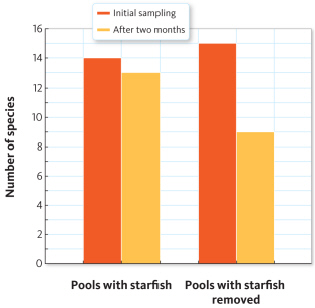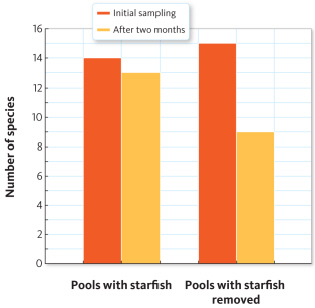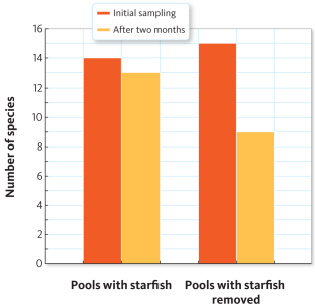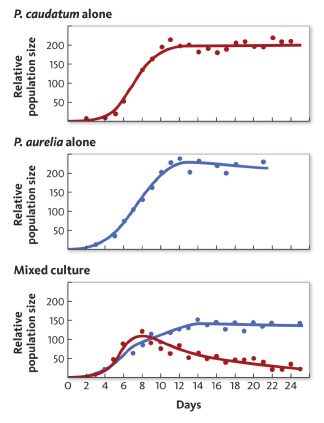A) True, this represents the number of individuals that the environment can support.
B) False, this does not represent the total number of individuals that an environment can support.
C) True, each year some organisms die and others are produced.
D) False, habitats and environments are not constant, unchanging entities.
F) A) and B)
Correct Answer

verified
D
Correct Answer
verified
Multiple Choice
A researcher surveys the number of salamanders in a population in Michigan each year. Over a 10-year period, the number of individuals that she counts in the population varies. This count of individuals refers to the __________.
A) carrying capacity
B) niche
C) species diversity
D) resource partitioning
F) C) and D)
Correct Answer

verified
Correct Answer
verified
Multiple Choice
In Chapter 3, you learned about the evolution of the 14 finch-like species on the Galapagos Islands. As shown in the figure below, each species has a different beak shape; thus, each species is adapted to feeding on different food sources.
 These changes are a result of __________.
These changes are a result of __________.
A) resource partitioning
B) ecological niche
C) dominance hierarchy
D) mutualism
F) A) and D)
Correct Answer

verified
Correct Answer
verified
Multiple Choice
If you own a dog, each year, depending on the region where you live, you will need to buy medication that treats roundworms and ticks and fleas. These organisms live either internally or externally on dogs and obtain all their nutrients from the dog. In some cases, dogs are harmed due to these interactions. This describes a __________ relationship.
A) commensal
B) mutualistic
C) parasitic
D) tertiary
F) A) and C)
Correct Answer

verified
Correct Answer
verified
Multiple Choice
Robert Paine was the first biologist to use the term keystone species in the 1960s. He was studying food webs in the rocky, intertidal pools in the Pacific Northwest. At one of his study sites, the dominant organisms in the tidal pools were mussels, barnacles, whelks, and a species of starfish known as Pisaster ochraceus . To examine the relationship between these species, Paine set up an experiment. In one area, he removed all the starfish from the tidal pools, and in an adjacent area, he left the tidal pools as he found them. Prior to removing the starfish, he sampled all the organisms in each pool. After two months, he repeated this sampling. A summary of his results is illustrated in the graph below.
 As mussels and barnacles feed, how much of the energy that they take in from food is available to the whelks that eat them?
As mussels and barnacles feed, how much of the energy that they take in from food is available to the whelks that eat them?
A) 10 percent
B) 90 percent
C) 1000 calories
D) 10,000 calories
F) A) and C)
Correct Answer

verified
Correct Answer
verified
Multiple Choice
A flock of flamingos wading and feeding in a lake is an example of a(n) __________.
A) organism
B) population
C) community
D) ecosystem
F) A) and C)
Correct Answer

verified
B
Correct Answer
verified
Multiple Choice
Certain types of mites can often be found attached to insects such as cockroaches and beetles. Often they are found around the mouth regions of their host, and they feed on any food particles around the mouth of the insect. This is likely what type of relationship?
A) commensalism
B) mutualism
C) parasitism
D) predation
F) B) and C)
Correct Answer

verified
Correct Answer
verified
Multiple Choice
In a simple laboratory experiment, a researcher maintained two different species of single-celled protists, Paramecium caudatum and Paramecium aurelia . He recorded population growth of each species individually and then mixed a similar number of individuals from each population and recorded their growth rates when living together. The graphs below represent the results of this experiment.
 What is the carrying capacity for P. caudatum alone?
What is the carrying capacity for P. caudatum alone?
A) ~200
B) ~100
C) ~50
D) cannot be determined from graph
F) None of the above
Correct Answer

verified
A
Correct Answer
verified
Multiple Choice
Lions are heterotrophic carnivores living on the African savannah. They live in prides with several females and a dominant male. Mating occurs in the summer. This describes the organism's __________.
A) habitat
B) niche
C) food web
D) carrying capacity
F) All of the above
Correct Answer

verified
Correct Answer
verified
Multiple Choice
Robert Paine was the first biologist to use the term keystone species in the 1960s. He was studying food webs in the rocky, intertidal pools in the Pacific Northwest. At one of his study sites, the dominant organisms in the tidal pools were mussels, barnacles, whelks, and a species of starfish known as Pisaster ochraceus . To examine the relationship between these species, Paine set up an experiment. In one area, he removed all the starfish from the tidal pools, and in an adjacent area, he left the tidal pools as he found them. Prior to removing the starfish, he sampled all the organisms in each pool. After two months, he repeated this sampling. A summary of his results is illustrated in the graph below.
 At one of Paine's study sites, the dominant organisms in the tidal pools were mussels, barnacles, whelks, and a species of starfish know as Pisaster ochraceus . These organisms together are a(n) __________.
At one of Paine's study sites, the dominant organisms in the tidal pools were mussels, barnacles, whelks, and a species of starfish know as Pisaster ochraceus . These organisms together are a(n) __________.
A) population
B) community
C) ecosystem
D) niche
F) C) and D)
Correct Answer

verified
Correct Answer
verified
Multiple Choice
Robert Paine was the first biologist to use the term keystone species in the 1960s. He was studying food webs in the rocky, intertidal pools in the Pacific Northwest. At one of his study sites, the dominant organisms in the tidal pools were mussels, barnacles, whelks, and a species of starfish known as Pisaster ochraceus . To examine the relationship between these species, Paine set up an experiment. In one area, he removed all the starfish from the tidal pools, and in an adjacent area, he left the tidal pools as he found them. Prior to removing the starfish, he sampled all the organisms in each pool. After two months, he repeated this sampling. A summary of his results is illustrated in the graph below.
 If this was an ecosystem-level study, what additional data might Paine need to collect?
If this was an ecosystem-level study, what additional data might Paine need to collect?
A) predation
B) communication and social groups
C) parasites
D) light levels
F) B) and D)
Correct Answer

verified
Correct Answer
verified
Multiple Choice
In spring, red-winged blackbird males return to their summer grounds where they compete for territories prior to the arrival of females. This is an example of __________.
A) resource partitioning
B) intraspecific competition
C) niche overlap
D) dominance hierarchy
F) None of the above
Correct Answer

verified
Correct Answer
verified
Multiple Choice
A beetle that feeds on the leaves of sunflowers is eaten by a spider. Possums will eat both beetles and spiders. If the sunflowers represent 2400 calories, how many calories would be available at the level of the possums that eat spiders?
A) 10
B) 2.4
C) 24
D) 1000
F) C) and D)
Correct Answer

verified
Correct Answer
verified
Multiple Choice
In a simple laboratory experiment, a researcher maintained two different species of single-celled protists, Paramecium caudatum and Paramecium aurelia . He recorded population growth of each species individually and then mixed a similar number of individuals from each population and recorded their growth rates when living together. The graphs below represent the results of this experiment.
 This example represents what type of competition?
This example represents what type of competition?
A) intraspecific
B) interspecific
D) undefined
Correct Answer

verified
Correct Answer
verified
Multiple Choice
Some species of bean bug, which are common pests on soybean plants, can acquire resistance to a common herbicide by nurturing protective bacteria in their gut. The bacteria grow well in the gut, do not cause any harm, and receive all their nutrients from the bean bug. This is an example of __________.
A) commensalism
B) mutualism
C) predation
D) parasitism
F) A) and C)
Correct Answer

verified
Correct Answer
verified
Multiple Choice
Which of the following is an example of resource competition?
A) male garter snakes vying for access to females
B) cardinals and starlings fighting over seeds in a bird feeder
C) interactions between parasites and their host
D) lions hiding near a water hole to capture prey
F) B) and C)
Correct Answer

verified
Correct Answer
verified
Multiple Choice
The image below represents the termites, bacteria, and protists that together share a mutualistic relationship.
 How many domains are represented?
How many domains are represented?
A) one
B) two
C) three
D) four
F) A) and C)
Correct Answer

verified
Correct Answer
verified
Multiple Choice
A beetle that feeds on the leaves of sunflowers is eaten by a spider. Possums will eat both beetles and spiders. If the sunflowers represent 2400 calories, how many calories would be lost as heat as you move from the first to the second trophic level?
A) 240
B) 2160
C) 90
D) 10
F) A) and B)
Correct Answer

verified
Correct Answer
verified
Multiple Choice
A beetle that feeds on the leaves of sunflowers is eaten by a spider. Possums will eat both beetles and spiders. The second trophic level in this food web would be filled by the __________.
A) beetle
B) spider
C) possum
D) spider and possum
F) B) and D)
Correct Answer

verified
Correct Answer
verified
Multiple Choice
A beetle that feeds on the leaves of sunflowers is eaten by a spider. Possums will eat both beetles and spiders. In this food web, the sunflower is __________.
A) the primary producer
B) the primary consumer
C) the autotroph
D) both the primary producer and autotroph
F) None of the above
Correct Answer

verified
Correct Answer
verified
Showing 1 - 20 of 41
Related Exams